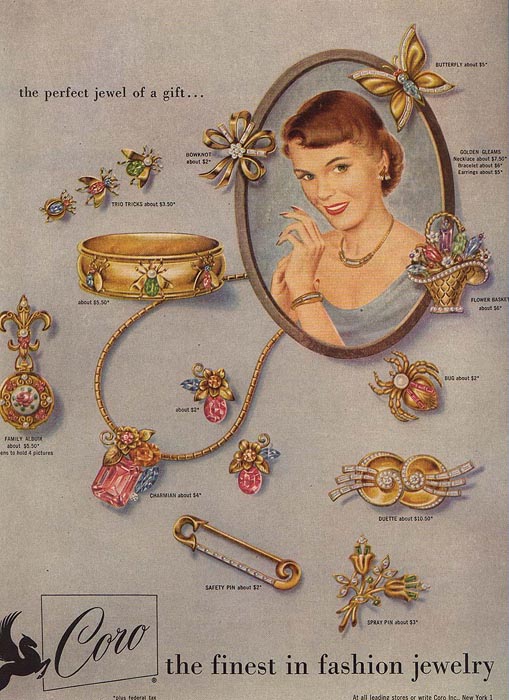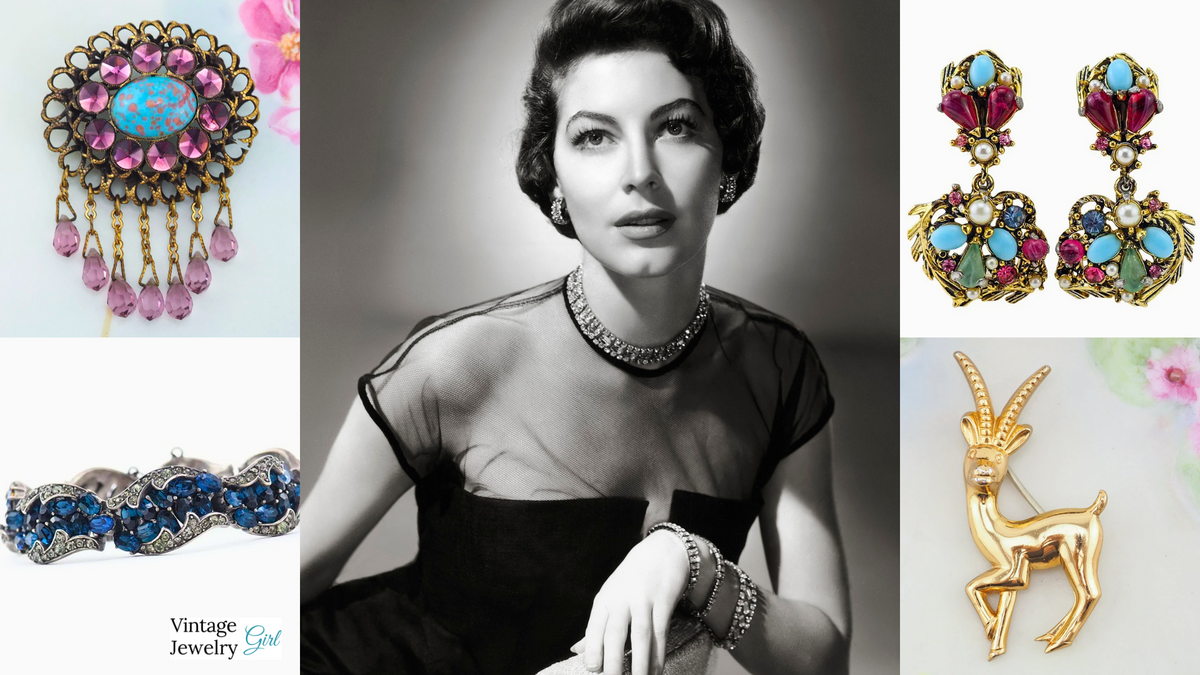1950s Jewelry & Fashion Trends
A guide to help you identify and date 1950s costume jewelry
You can see our current and past selection of 1950s and 1960s jewelry here to get a better idea of the trends of the time.
This guide to 1950s jewelry and fashion will help you identify and date your vintage costume jewelry! Even for people who are accustomed to handling and wearing vintage jewelry, dating can be challenging. This is because styles and elements from previous decades were brought back to life repeatedly throughout the decades. This page will provide you with a taste of 1950's jewelry and the styles that accompanied it. So, what were the 50s like, and what styles and ideologies helped guide fashion during that time? The 1950s was a decade of glamour and sophistication, and the jewelry of that era perfectly captured the essence of the time. From the rise of Hollywood stars to the influence of the post-war economic boom, the 1950s jewelry trends reflected a newfound sense of optimism and prosperity. You can use this fun list of fashion trends to determine whether you are truly a 50s soul.

You know you should have been born in the 1950s if you:
- are politically conservative
- love shiny new things - Swarovski created their iconic "Aurora Borealis" effect for rhinestones in 1956.
- own a pair of dungarees that you wear with your father’s shirt
- own a chemise
- dream about the Yves Saint Laurent ‘trapeze’ dress
- love to sport a pair of capris and a flat ballet-style shoe
- own a petticoat and you wear it under your circle skirt
- own a ‘bucket’ or ‘pillbox’ hat
- ♥ ‘kitten heels’
- adore Audrey Hepburn’s style
- have one of these cuts or hairstyles
- ‘flip’ over the following types of jewelry on this page!
The influence of 1950s fashion on jewelry
The fashion of the 1950s played a significant role in shaping the jewelry trends of the time. The hourglass silhouette, popularized by icons like Marilyn Monroe and Audrey Hepburn, called for jewelry that accentuated the feminine curves. Statement necklaces adorned with pearls and rhinestones became a staple accessory, adding a touch of elegance to the classic 1950s dresses.
Another prominent influence on 1950s jewelry was the rise of the cocktail culture. With the end of World War II, people were eager to celebrate and indulge in the newfound prosperity. This led to an increase in social events and cocktail parties, where women showcased their finest jewelry. The cocktail rings, featuring large gemstones set in intricate designs, became a symbol of opulence and sophistication.

1950s jewelry was more refined than that of the 40s big retro styles. It was glitzy, sometimes emulating fine jewelry, and sometimes obviously faux. Faux pearls were common and multi-strand necklaces were immensely popular. Brooches were a wardrobe staple, often being worn in groups on the shoulder. Gold-tone pieces such as wide bracelets and big button earrings were worn as daytime jewelry and the “diamond look” was often seen in the evenings. Sets of matching pieces completed the modern women’s look. As post-war incomes increased and women desired more choices in their accessories, new styles in copper and plastics provided the variety they were looking for. What follows is a window into the past of how women adorned themselves in the 1950s.

Carmen Dell’Orefice models a variety of 1950s ring fashions. In this photo, you can see the trend of big, obviously faux gemstone rings, with an emphasis on the faux pearl.





Above is a 1950s vintage jewelry advertisement from Eisenberg showing flexible crystal bracelets popular in the 50s. Much of the popular costume jewelry of the 1950s was made to resemble fine jewelry, utilizing quality crystals and gold and rhodium plating. Manufacturing techniques employed a combination of hand-craftsmanship and modern production innovations.

Above is a fashion ad from 1952 showing the common trend of wearing multiple small pins together with some in the atomic style on the right.

Above is an image of a chiffon 1950s Dress by Herbert Sondheim produced in Vogue in May 1957. This image shows a number of popular jewelry trends. Big rings, flexible rhinestone bracelets, and multi-strand necklaces were popular in the 50s. Although sets were commonly worn, this image shows the styling of various different pieces together which gives the look a timeless appeal.

Multi-strand beaded necklaces were immensely popular. The image above is for Richelieu ‘Tahiti’ jewelry produced in the1950s. According to Harrice Miller, “Beads ranged from the monochromatic in 1957 to vivid shades in 1958 that come in all textures, including faceted baroque pearls and brushed gold”. source

As popular as the fine look of rhinestones was, the faux look was also quite chic! Women looked for variety in their jewelry as post-war incomes were stabilizing and evening socializing was becoming commonplace. Also, rhinestones did not appeal to everyone. Copper jewelry was the preferred choice for the Beatnik generation who craved an alternative to the glamorous look of crystals. The ad above shows two bracelet sets by Renoir in the patterns ‘flame’ (top) and ‘rhythm’ (bottom). The copper designs in the 50s were influenced by the Arts and Crafts era which also showed a popularity in this artisan-friendly metal.


In addition to rhinestones and copper, plastics were commonly used in jewelry in the 1950s. Being less expensive to manufacture and more chemically stable, lucite came to dominate the plastic jewelry manufacturing industry. It could be made clear like glass and rock crystal or more opaque or frosted as shown in this vintage Lisner jewelry advertisement from 1958. It’s interesting to note that the set of necklace, bracelet, pin, and earrings cost $8.00 USD in 1958 (as stated in the ad). That’s equivalent to $83.55 USD in 2023 according to the US inflation calculator! Lucite was versatile and could be used to embed objects such as seashells and pieces of confetti. Another popular way to use lucite in jewelry was to carve and paint it from the back so the design would show through the front as seen in the earrings above. This is known as ‘reverse carved lucite’.

The distinction between jewelry to be worn at night versus daytime was apparent for the first time in the 50s. This excellent article, which is part of the “vintage jewelry workshop” by Lynn Alber tells us that “Jewelry set in goldtone finishes had colored stones but no diamonds – for day. “Cocktail” jewelry was worn in the evening.” This Boucher ad shows jewelry destined to be worn in the evening.
-------------------------------------------------------------------
Essential Features of 1950s Jewelry: 11 Key Points
1950s Jewelry varied on the spectrum from glamorous and elegant to fun and artsy. Looking at the styles of the decades that came before and after can also help you to date your vintage jewelry. New fashions evolved from previous styles, so knowledge of manufacturing techniques through periods in history can help in pinpointing the age of your jewelry.
- Retro and Atomic Age Influence: The 1950's jewelry designs were heavily influenced by the post-World War II era. The Retro and Atomic Age styles were prominent during this time, with jewelry reflecting the optimism and innovation of the period.
- Chunky and Colorful: Jewelry in the 1950s was often chunky and bold, featuring large, colorful gemstones and crystals. This era also saw a resurgence in the popularity of pearls.
- Cocktail Rings: Cocktail rings were a significant trend in the 1950s. These rings were often large and featured eye-catching gemstones like sapphires, rubies, and emeralds. They were designed to be worn to cocktail parties, symbolizing elegance and sophistication.
- Costume Jewelry: Costume jewelry was widely popular in the 1950s, as it allowed people to achieve a glamorous look without spending a fortune. Designers like Miriam Haskell and Christian Dior produced exquisite costume jewelry pieces that imitated the look of fine jewelry.
- Gold and Silver: Yellow and rose gold were commonly used for jewelry in the 1950s. Additionally, silver jewelry was popular, especially for more casual or everyday wear. Silver was often paired with colorful gemstones and crystals for a vibrant look.
- Innovative Materials: During this period, jewelry designers continued to experiment with new materials such as thermoplastics to create colorful, chunky bangles, bracelets, and stones which allowed for unique and playful designs.
- Nature-Inspired Designs: Nature served as a significant source of inspiration for jewelry designs. Motifs like flowers, leaves, and animals were common. Pieces featuring delicate enameled flowers and bird motifs were especially popular.
- Choker Necklaces: Choker necklaces became a fashion staple in the 1950s. They were often made with pearls or rhinestones and were worn close to the neck, accentuating the elegant necklines of the era's dresses.
- Mid-Century Modern Influence: The clean lines and geometric shapes of the mid-century modern design movement influenced jewelry designs. You can find pieces with sleek, minimalist designs and abstract patterns from this period.
- Celebrity Influence: Jewelry worn by celebrities of the time, such as Marilyn Monroe and Audrey Hepburn, had a significant impact on fashion and jewelry trends. Their iconic jewelry choices helped popularize certain styles.
- The Aurora Borealis (AB) Finish for Crystals was developed by the Swarovski company in the 1950s (1956). Swarovski is well-known for its high-quality precision-cut crystals and innovative coatings, and the AB finish is one of their most iconic creations. This special finish gives crystals a dazzling and iridescent effect, reflecting a spectrum of colors and resembling the Northern Lights (Aurora Borealis), which is how it got its name. The invention of the AB finish revolutionized the jewelry and fashion industry, as it added a new level of brilliance and glamour to crystal jewelry and accessories. Although an "Iridescent finish" was used on stones and beads prior to the 1950's, Swarovski crystal stones with the AB finish are not seen until after this creation date.
I hope you found this guide helpful and will continue to follow us on Facebook, Instagram or browse our curated selection of great vintage jewelry!

I love vintage ,,,,1950,s charm bracelets. Wide bracelet and very large one of a kind charm’s. Willing to spend money. Thankfully yours Glendell Trotman
Pearls indeed evoke a vintage style. You simply cannot overlook the exquisite shine of these pearls. I was searching for vintage dress jewelry in NZ and came across your blog—a great, detailed article that I thoroughly enjoyed.